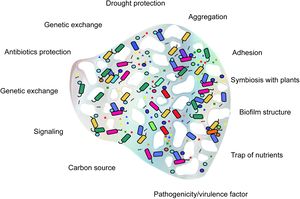Extracellular polymeric substance: Difference between revisions
No edit summary |
No edit summary |
||
| Line 8: | Line 8: | ||
== Function == | |||
'''Habitat stability''': | |||
The suspected primary role of EPS is to create stable habitat bound to a desired substrate[]. Very common substrates are soil particles within the soil pore matrix however, many surfaces can be used to create biofilms with EPS. Biofilms are very effective at retaining water in soils even with very negative water potentials.[] | |||
'''Implications''': | |||
'''Hydrology''': | |||
EPS resists evaporation by binding the water tightly[]. The biofilms formed with EPS can cause bioclogging of pores which resists evaporation and mass flow of water by reducing the hydraulic conductivity[]. This slows the rate of change in soil moisture content. | |||
EPS plays | |||
'''Soil structure''': | |||
EPS production fills soil pore space which reduces the effective average pore size[]. For the potential impacts of this see [porosity]. Also, the swelling shrinking actions of EPS water intake and loss can alter the pore space but there remains a lack of literature differentiating this effect from bulk soil[]. | |||
EPS plays a key role in soil aggregate formation by working as a cementing agent. This has the added effect of reducing soil slaking and increasing overal stability. This added stability can lower errosion rates and decrease nutrient runoff. | |||
'''Plants and nutrients''': | |||
'''Agriculture''': | |||
'''Extraction methods''': | |||
Revision as of 13:28, 10 April 2021

Extracellular polymeric substances (EPS) are a group of substances exuded by microorganisms in order to form biofilms. The major components are extracellular polysacharides (also called EPS), protiens, DNA, enzymes, lipids, and other biopolymers.[2] EPS accounts for 90% of biofilm drymass and constitutes the matrix of the biofilm.[3] Biofilms are microhabitats that keep microbes attached to a substrate[4], provide protection from desiccation[5][6]
, and play a key role in nutrient cycling[7]. Biofilms are also known to alter the structure [8][9], hydrology [10][11][12][13], and composition [14][15][16]of soils.
Function
Habitat stability: The suspected primary role of EPS is to create stable habitat bound to a desired substrate[]. Very common substrates are soil particles within the soil pore matrix however, many surfaces can be used to create biofilms with EPS. Biofilms are very effective at retaining water in soils even with very negative water potentials.[]
Implications:
Hydrology: EPS resists evaporation by binding the water tightly[]. The biofilms formed with EPS can cause bioclogging of pores which resists evaporation and mass flow of water by reducing the hydraulic conductivity[]. This slows the rate of change in soil moisture content. EPS plays
Soil structure: EPS production fills soil pore space which reduces the effective average pore size[]. For the potential impacts of this see [porosity]. Also, the swelling shrinking actions of EPS water intake and loss can alter the pore space but there remains a lack of literature differentiating this effect from bulk soil[].
EPS plays a key role in soil aggregate formation by working as a cementing agent. This has the added effect of reducing soil slaking and increasing overal stability. This added stability can lower errosion rates and decrease nutrient runoff.
Plants and nutrients:
Agriculture:
Extraction methods:
Header
<ref> tag; refs with no name must have contentwords. [source]
Examples
Bold Text: regular text
References
- ↑ <a href="https://doi.org/10.3389/fmicb.2018.01636">Costa et al.</a>,<a href="https://creativecommons.org/licenses/by/4.0">CC BY 4.0</a>, via Frontiers in Microbiology
- ↑ {{#invoke:Citation/CS1|citation |CitationClass=journal }}
- ↑ {{#invoke:Citation/CS1|citation |CitationClass=journal }}
- ↑ {{#invoke:Citation/CS1|citation |CitationClass=journal }}
- ↑ {{#invoke:Citation/CS1|citation |CitationClass=journal }}
- ↑ {{#invoke:Citation/CS1|citation |CitationClass=journal }}
- ↑ {{#invoke:Citation/CS1|citation |CitationClass=journal }}
- ↑ {{#invoke:Citation/CS1|citation |CitationClass=journal }}
- ↑ {{#invoke:Citation/CS1|citation |CitationClass=journal }}
- ↑ {{#invoke:Citation/CS1|citation |CitationClass=journal }}
- ↑ {{#invoke:Citation/CS1|citation |CitationClass=journal }}
- ↑ {{#invoke:Citation/CS1|citation |CitationClass=journal }}
- ↑ {{#invoke:Citation/CS1|citation |CitationClass=journal }}
- ↑ {{#invoke:Citation/CS1|citation |CitationClass=journal }}
- ↑ {{#invoke:Citation/CS1|citation |CitationClass=journal }}
- ↑ {{#invoke:Citation/CS1|citation |CitationClass=journal }}